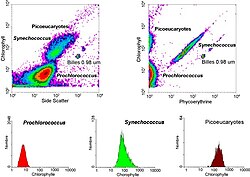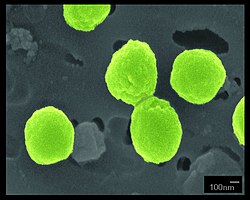Adsorption of a cyanophage onto a marine prochlorococcus
(a) Slice (~20 nm) through a reconstructed tomogram of P-SSP7 phage incubated with MED4, imaged at ~86 min post-infection, and (b) corresponding annotation highlighting the cell wall in orange, the plasma membrane in light yellow, the thylakoid membrane in green, carboxysomes in cyan, the polyphosphate body in blue, adsorbed phages on the sides or top of the cell in red, and cytoplasmic granules (probably mostly ribosomes) in light purple. FC and EC show full-DNA capsid phage and empty capsid phage, respectively. Scale bar is 200 nm.
Relevante Bilder
Relevante Artikel
Prochlorococcus marinusProchlorococcus marinus ist die einzige bekannte und wissenschaftlich beschriebene Art der Gattung Prochlorococcus. Es ist ein vorwiegend marin verbreitetes, Photosynthese betreibendes, einzelliges Cyanobakterium. Prochlorococcus gehört zu den kleinsten bekannten photoautotrophen Organismen und damit zum sog. Picoplankton. Aufgrund seiner hohen Konzentration in weiten Bereichen der Ozeane ist er nach aktuellem Forschungsstand das Lebewesen mit der höchsten Individuenanzahl und zugleich das am weitesten verbreitete Lebewesen der Erde und spielt bei der Primärproduktion organischer Stoffe eine besonders große Rolle. .. weiterlesen
AutographiviridaeDie Autographiviridae sind eine Familie von Viren in der Ordnung Caudovirales – sie wurden dort früher als Unterfamilie Autographivirinae in der früheren Familie Podoviridae geführt. Ihre natürlichen Wirte sind Bakterien. Es gibt derzeit 40 Arten (Spezies) in dieser Gruppe, die meisten davon sind einer von ca. sieben Gattungen zugewiesen. .. weiterlesen








